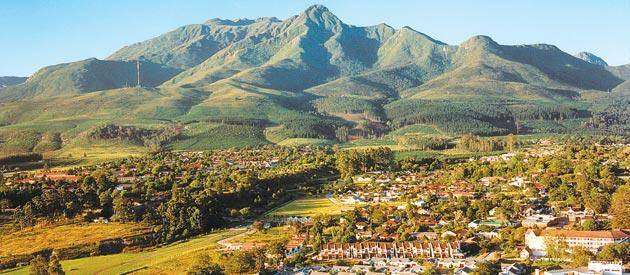History of George
- Province: Western Cape
- Garden Route
- Coordinates:33°58′S 22°27′E
- Area:77.4 km2
- Municipality: George
Forestry Station
The town was founded to meet the demand for timber needed for construction, transport, and furniture. While the vast forests of the Southern Cape were discovered as early as 1711, their inaccessibility delayed exploitation until 1776, when the Dutch East India Company established an outpost in the area. The region was known for its abundant forests, which provided a valuable source of timber.
Establishment of the New Municipality
Under British occupation, a forest caretaker was appointed, and in 1806, it was decided that the Swellendam municipality was too large. George was identified as an ideal location for a new town, largely due to its water resources. The town was officially proclaimed in 1811 by the Earl of Caledon and named after King George III. Originally named Georgetown, it was the first to be proclaimed at the Cape; The first local authority was elected in 1837, and George gained municipal status in 1884. A Dutch Reformed Parish was established in 1812, with TJ Herold as the first minister, after whom the nearby village of Herolds Bay is named.
Irrigation System
The town’s first magistrate, Tiaan Swart, planned an irrigation system using furrows to bring water from the river into town. The 1819 town map shows these early furrows and a storage dam, which still exist today in the Garden Route Botanical Garden. The initial water source was the Rooirivier (Red River), later supplemented by a weir on the Camphersdrift River.
The town layout included plots and wide streets lined with oak trees, one of which has been declared a natural monument. A chain embedded in its trunk is linked to a story that slaves were once fastened to it and sold beneath the tree.
Railway Triggers Growth
The town experienced growth when people who had lost their businesses during the slump in the ostrich feather industry and a severe drought in the early 18th century settled in the town, hoping to find work in the forestry industry. The arrival of rail and road links further accelerated the town’s growth, as timber, which was previously transported to coastal ports by ox-wagon, could now be moved more efficiently.
The local economy
Today, George is home to a diverse range of industries, including shoe factories, soft drink production, and furniture manufacturing. The railway sleeper depot, once owned by South African Railways, was taken over by the Forestry Department in 1937, eventually becoming a state sawmill and timber preservation facility. The district also supports dairy farming, sheep farming, and the cultivation of wheat and vegetables. Notably, George is the only place in South Africa where hops are grown.
Rehabilitation of the Forest
Due to extensive logging, much of the original forest was depleted. To address this, a nursery was established at Witfontein in 1896 to supply saplings for replanting the denuded slopes with pine trees. In 1936, the government implemented a 200-year ban on the felling of existing trees to allow the forests to recover and to protect indigenous species such as stinkwood and yellowwood.
The Licence plate prefix for George is CAW. Local postcodes here
local WEATHER TODAY
All listings in George
Things to see and do in George
- The 60 km national road between George and Knysna was completed in 1951
- The Montague Pass was the first road between George and Oudtshoorn, Beveraaskloof Pass
- Voortrekker pass
- MTB, running, and hiking trails
- Swartriver pass
- Agricultural Show August
- Open Gardens in October, georgeopengardens@gmail.com
- Silver River Pass
- Tourism
- Homtini pass
- The Old Slave tree in York Street is a big oak tree It was planted in 1811 by Landros van Kervel. There is an old lock attached to the tree. Legend has it that the lock was to chain slaves to the tree when the site was still occupied by the jail.
Useful Numbers
- Police: 044 803 4400
- Traffic department:044 878 2400
- Home affairs: 044 805 4100
- Fire: 044 801 6300
- `Water: 044 801 9266
- Electricity: 044 801 9222 or 044 874 3917
- Ambulance:10177
- Post office: 044 874 1212
- Library:044 801 9288
- Closest hospital: 044 874 5122 George Hospital, 044 802 4528 Mediclinic-044 803 2000
- Pharmacy; King George Chemist-044 873 2420
- SPCA: 044 878 1990 083 262 593
- Museum; 044 873 534
- Tourism; 044 873 6355
- Schools
- St Mary’s Primary School- 044 875 8450
- Curro Castle George- 044 805 3300
- Carpe Diem School -Special education school- 044 874 4074
- Van Kervel School- 044 874 2042
- Rosemoor Primary School- 044 875 8820
- Denneoord Primary School
- Laerskool Denneoord- 044 873 3439
- Thembalethu High School- 044 880 9180
- Conville Primary School- 044 875 8340
- Parkdene Primary School- 078 320 8712
- Heidedal Primary School- 0448758330
The George municipality includes the areas of Fremersheim; Glentana; Pascaltdorp; Rheenendal; Uniondale; Victoria Bay; and Wilderness



